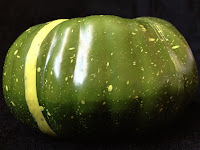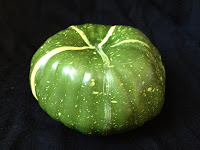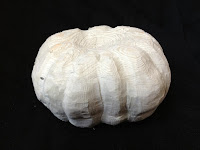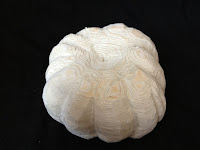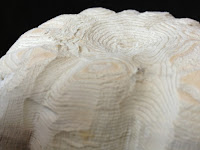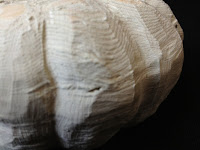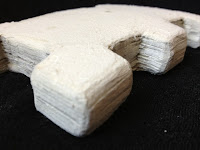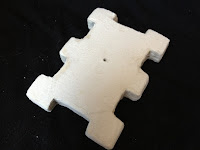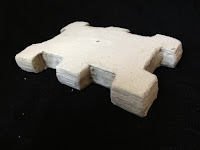For this project I chose to push myself, and so I chose a rather oblong pumpkin to work with. I had no idea the task I got myself into! For starters, because of the shape of the pumpkin I didn't want to shape the layers of paper as I stacked. Instead, I simply traced the pumpkin at its widest point and made all of the layers that shape.
Many hours, one and a half bottles of Elmer's wood glue, and five sheets of that $8 paper later, I was finished gluing and stacking. Knowing it was sand-able I was using the glue to my advantage, using as much of it as I could on each layer without it bubbling over the size when I put down the next layer of paper.I let it dry overnight, and the next morning I noticed that part of the uppermost layers had "warped" and curved, but I decided not to allow that to be a hindrance.. Instead, I used it to my advantage! I borrowed a power sander from my handy-dandy boyfriend, and started sanding.
(Sidenote: Be careful with these sanders! I have shed more blood for this class than any other -- extra credit? ;] )
Sanding was extremely difficult because of the sheer amount of it that had to be done. I was two hours in before any kind of actual shape began to form. I had to work with the warping of the paper, which became more of a hindrance than anything because it took more to sand those layers than the others, but finally it began to take shape... And many hours later, voila! Masterpiece!
I am incredibly proud of my pumpkin. Sure, maybe it doesn't look as close to my oblong-y pumpkin as I would like, but that's okay!
For my abstract fruit I decided to look back on my roots -- German roots, that is! I wished to play homage to the German architecture and a lot of the contrasting lines involved, and so chose a highly geometric style including lots of straight edges. The piece looks highly castle-esque. I sanded the edges to round them a bit to bring it closer to being a "fruit", and instead of creating a stem that wound its way up and out of the piece, I drilled a hole into it. Why? It started by accident, but then I decided I liked it -- because it was supposed to be abstract, why couldn't it have an inverted stem? Then to play on narrative, I decided that this fruit would come from a thin vine -- and the actual fruit itself would
slide off of the vine, instead of needing to be cut. Why not!

.jpeg)
.jpeg)
.jpeg)
.jpeg)
.jpeg)
.jpeg)
.jpeg)
.jpeg)
.jpeg)
.jpeg)
.jpeg)

.jpeg)
.jpeg)
.jpeg)

.jpeg)

.jpeg)
.jpeg)
.jpeg)
